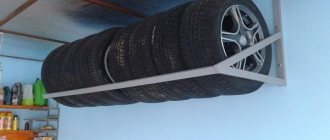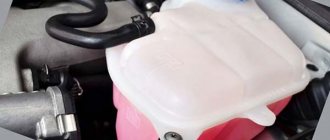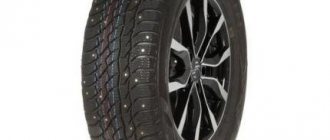As a rule, any car owner has at least two sets of tires - winter and summer. Accordingly, the question of storing an unused set of tires arises. Some car owners do not wonder how to properly store tires. As a result, the tires become unusable and you have to incur additional costs to purchase new tires. Moreover, you can ruin a summer set literally within a season. As a result, in the spring, instead of taking off winter tires and putting on summer tires, you will have to purchase a new set of tires. And all the problems are only due to improper storage of tires in your garage. By the way, you can store tires not only in the garage. There are special organizations that accept car tires for storage, providing proper conditions and care.
Preparation
The steps and steps are listed below.
Cleansing
It is better to wash the ramps together with the car, then dry the wheels and proceed to the following steps:
- Complete cleaning begins with mechanical removal of dirt and dust. Here you can use soft brushes and rags.
- Next, you will need to remove small particles of soil and dust. To do this, prepare a soap solution, a special brush and thoroughly wash the rubber surface. It is prohibited to use aggressive detergents or solvents that may come into contact with rubber-containing mixtures.
- Check the pressure in the cylinders. This information should be viewed on the rubber manufacturer's website. Typically the figure is from 0.8 to 1.2 Atm.
- The last step is to completely dry the stingrays. Ideally, just leave the tires in the shade until they dry completely.
Further actions depend on the storage method, but the requirements for cleaning the room from dirt, dust and other debris are relevant regardless of the chosen method.
Coating
We put on a protective layer to prevent damage to the integrity of the rubber. Typically, car enthusiasts use the following.
- Special mixtures based on silicone. Similar products can be found at any auto store at a low cost. The use of the composition is simple. Spray the mixture onto the rubber and leave it to dry for a while.
- Talc. This composition was used when various mixtures were not yet available on the market. Here it is important to generously sprinkle the tire with powder on all sides and shake off the residue.
When processing, do not lubricate the rubber with grease or oil - this may damage the working surface.
Marking
The driver may need this procedure if the ramps will be stored separately from the discs. Marking the tire sidewalls and rim eliminates the need to re-balance the wheels when reinstalling the ramps on the rims. Otherwise, you will need to go to a service station and pay money to the technicians.
Basic nuances of storage by type of tires
Tube and tubeless tires
- In this case, the tube should be stored inside the tire in a slightly inflated state. This is done so that folds, bedsores and cracks do not form on the product, and the camera itself lasts longer. The tire should be on edge and regularly rotated 90 degrees at least once a month. This is necessary so that the cord does not deform.
- The storage requirements for tubeless tires are the same as for tube tires.
Difference in conditions for the safety of summer and winter tires
The differences in how these tires are stored are small, but they still exist. So:
- Before storing winter tires, they must be thoroughly washed to remove reagents and other chemicals used to treat roads. It is enough to wash away dust and dirt from summer wheels.
- Summer tires can be stored outside (under a canopy) in winter, but not for long, about a month, and with some reservations (see below).
- If the car is not used in winter and is parked on the street with summer tires installed, you need to jack up the car using a sawhorse (boards or wooden beams), thus unloading the tires. In this case, it is better to lower the tire pressure, the minimum allowable is 0.6–0.8 atmospheres. At the beginning of its service life, the car is first lowered, and then the wheels themselves are inflated to the required parameters.
How to store tires with and without rims (wheel assemblies)
There are several common techniques. Typically, car enthusiasts store ramps while standing or lying down. Each method has its own advantages and disadvantages.
When storing, keep in mind that you will need to periodically turn the tires over to change the deformation point. When horizontal, the tires must be properly inflated. If the wheels are deflated, their own weight will flatten them and the tires may be damaged.
You can store rubber in an unheated room during severe frosts. This applies specifically to winter tires. Stingrays can easily withstand changes from -30 to +30 degrees Celsius. Summer skating rinks should be sent for storage correctly.
- It is recommended to use a heated room with moderate humidity, without sudden temperature changes. A storage room, a dry cellar, and a heated balcony are suitable here.
- Tires cannot be stacked.
- Periodically, the rubber turns over to the other side.
Rollers should absolutely not be stored in plastic bags or bags. The sealed film creates ideal conditions for condensation and rotting.
Adaptations
Tires on rims can be hung by the metal part - the balloon does not deform when inflated. Tires without titanium are installed for storage on a special stand. The device holds the products in the desired position and avoids deformation. Standard diagrams of such racks can be found on the Internet or from experienced car enthusiasts.
What's the best way to store tires?
Preservation of tires in an inflated state is considered ideal. This minimizes the likelihood of deformation or aging, and the formation of defects in the cord part. This preservation method will allow you to quickly replace the rollers yourself when there are multi-day queues at the service station.
If you do not have an additional set of rims, you can place tires without them, but certain requirements must be met.
Storing winter tires
After the end of winter, a period comes for all car owners when it is necessary to change their winter set of tires to summer ones. In this case, the problem is caused by the fact of replacement itself, but by the need for proper storage of tires throughout the entire summer period of operation.
The rules are simple:
- It is definitely worth marking winter tires in terms of their position on the car (front left, rear right, and so on), and after the summer when installing, swap them in order to evenly distribute wear;
- Before laying, the tires must be washed with water and dried thoroughly, remove dirt and stones from the tread;
- if you plan to store winter tires on rims, it is better to hang them or lay them horizontally;
- dismantled winter tires without rims should not be hung, it is better to place them vertically or stack them in a lying position;
- It is undesirable for tires to lie or stand in one position; the correct thing to do is to periodically change their position, rotate them by 20 degrees, and it is necessary to note how long they are in one state;
- It is necessary to ensure that winter tires are kept away from solvents and other chemicals, as well as gasoline, diesel fuel, and oil.
Selecting a location
If the driver wants to store tires at home, care must be taken to select the right place where the tires will not interfere and will retain their properties.
In the garage
In most cases, drivers store car tires next to the swallow. Here the rubber is folded or hung on special hooks. An important factor is maintaining optimal humidity and temperature. For proper preservation, the room must be dry and temperature changes minimized.
Balcony
If there is too little space in the garage, users prefer to use the space in their home or apartment for storage. It is recommended to use a heated room or at least the balcony should be glazed.
A special rack is made for tires. The prepared rubber is placed in it and covered with some kind of fabric or coating that prevents sunlight from entering.
How to store wheels in a car
It doesn’t matter here whether the tires are on rims or without them. The main thing is that they do not move randomly over each other, but are located alone.
Rules for storing used tires at the enterprise
There are points taken into account here.
- Fire safety. Stingrays are a flammable material.
- Factory recommendations for tire placement relative to its operating condition.
- Ventilation and humidity maintenance.
Storage in tire service
The correct option for preservation is to hand over the tires to a specialized organization. In large cities, it is not uncommon to have companies involved in the storage of rubber materials and tires. Here, specialists will properly prepare the ramps and take care of them until the car enthusiast needs them.
Essentially, this procedure looks like this.
- The driver brings the skates to the service.
- When accepting tires, specialists issue the client a special coupon and accept prepayment for storage.
- At the end of the period agreed in advance, the user comes to the station and picks up his own tires.
Is it possible to store tires outside?
In case of emergency, such placement is permissible. This can only be done in compliance with certain rules.
- The place should be well ventilated.
- Avoid exposure of rubber to sunlight or direct sources of color.
- Completely prevent any precipitation in the form of snow or rain from getting on the tires.
Is it possible to store rubber in a cellar?
The conservation technique is no different from other options. The slopes need to be washed and placed on the rack. An important factor is maintaining dryness and good ventilation. Cellars are often damp and the air in them stagnates.
Gadgets and equipment for home convenience
Packages, bags
The package is a cheap and common device. Rubber on rims should not be stored in a plastic bag without access to air; condensation can cause corrosion and further damage. You don't have to worry about tires without rims.
The bags must allow air to pass freely if the tires are stored on rims
Cases
Like packages, they are quite common. They are more expensive, but have better consumer properties. The ideal case is breathable, moisture-resistant and opaque.
Tire cover keeps dust and sunlight out
Cabinets, racks, shelving
A tire cabinet is a useful tool. You can store wheels without discs “on the edge” in it, without them being able to fall or fall to one side. There are also cabinets for storing tires on rims.
Storing rubber assemblies on a rack is a common mistake.
Tire brackets
Externally, the brackets look like shelves. Usually welded from a metal profile. Allows you to place the rubber vertically without taking up much space.
The bracket can be hung from the ceiling, so it will not take up much space
Basic mistakes
The most common are:
- Incorrect position of tires when storing them. Drivers often stack products on top of each other or pack tires tightly so that they become deformed. This leads to the formation of hernias or damage to the cord.
- Store in direct sunlight. The surface dries out and cracks, which ultimately causes it to be written off.
- Storage at high humidity. So the tires can trample with all the ensuing consequences.
- Storage near electrical appliances or heating systems. Extreme heat damages your tires. Additionally, this is a direct violation of fire safety.
- Some drivers store tires in plastic bags. There are some conditions. The use of special bags for car tires is permitted. The structure of the product is breathable and does not provoke condensation during sudden temperature changes. If ordinary plastic is used, this is strictly unacceptable.
What should be the optimal storage temperature?
According to the requirements of GOST R 54266–2010, which is currently in force, the temperature difference during storage can be from –30° to +35°C. In this case, rubber stored in low-temperature conditions must be brought to above-zero temperatures corresponding to the given season before use.
Any heat source should not be closer than a meter from the place where the rubber is stored.
It is unlikely that the owner of these wheels will be able to use them for a long time after storage: the rubber is not protected from moisture or the sun
How long can you store car tires?
Regardless of the model and manufacturer, the warranty period does not exceed 5 years from the date of release of the product. With subsequent use, the rubber begins to lose elasticity, cracks or hardens, which provokes a decrease in grip characteristics and durability.
Here, supporters of Soviet quality will say that products made in the USSR are still used on the roads and nothing bad happens. The answer is simple. Such ramps are used on low-speed equipment, where active loads are not applicable. If you start driving aggressively on such a tire or brake sharply at speed, there is a high probability that the product will become unusable.
Additional Tire Preservation Tips
- If there is no room for tires at home, on the balcony or in the garage, you can contact tire hotels. Their services are relatively inexpensive, and the “shoes” will be stored correctly, in compliance with all conditions.
- Do not store tires in the same place with flammable substances and chemicals. They can corrode tires.
- After changing, the rubber can be blackened and treated with talc to prevent drying out and moisture.
- It is also recommended to treat the discs with an anti-corrosion compound. This will protect them from possible condensation.
Best places to store tires
- On the glazed balcony of an apartment or house, which is constantly heated.
- In a dry storage room, provided that the likelihood of temperature changes and exposure to the sun, as well as high humidity, is excluded. Please note: there should be no chemicals in the pantry.
- In a heated garage with a flat floor.
- In a dry cellar.
- In specialized warehouses designed for storing tires. Placing products at such facilities is a paid service, but the conditions in such premises are close to ideal.
Storage rules on the balcony
A balcony is an ideal place to store tires without rims if you have an apartment but no garage. At the same time, it is necessary to be aware of all the advantages and disadvantages of this room, as well as its features. To properly store tires without rims on the balcony, the location must be glazed and heated. Otherwise, you will not be able to maintain the temperature regime.
In addition, the balcony should be located on the side of the house where the sun's rays do not reach. Otherwise, you will have to cover the windows so that your disks do not become deformed in this room.
Specialized tire hotels
How to store summer tires in winter if there is neither a garage nor space on the balcony? Today, there are a number of specialized centers that provide space for seasonal storage of rubber.
Such tire “hotels” independently pick up wheels from clients, place them on specially equipped sites and provide optimal conditions for the safety of tires during the winter season.
The only disadvantage of this service is its cost. The average price tag in Moscow is about 80 rubles per day. Storage costs 2,400 rubles per month, and by spring it’s almost 7,000!
Specialized tire hotels
Are such expenses justified? If a set of tires costs more than 100 rubles. or you are not used to saving on quality maintenance, then the question is “how to store summer tires on rims in winter?” disappears by itself. One call and the professionals will take care of your wheels.
Well, mere “mortals” have to make do with old proven means – spacious loggias and garages.
The influence of external factors on rubber
The basis of any tire is rubber. This is pure rubber, characterized by high wear resistance and density. But it is not suitable for car tires because it is very hard, which is why the wheel will not get proper grip on the road. Therefore, when making skates, various impurities are added to it:
- sulfur - increases tire durability;
- soot - is a cheap filler that gives a black color;
- iron - the cord and the base of the landing board are made from it.
When exposed to external factors, these components begin to lose their properties. Because of this, microcracks appear on the tire. The rubber becomes stiffer and loses its elasticity, which subsequently significantly reduces its grip on the road. To prevent this from happening, follow at least the basic storage rules and choose a suitable place for the wheels of your car.
4/5 — (2 votes)
Temporary storage
As an experiment, we fit two sets of wheels into 1 m³. But you can’t store them like that.
As an experiment, we fit two sets of wheels into 1 m³. But you can’t store them like that.
If a family has several cars, then it makes sense to use a temporary storage warehouse. It's cheaper that way.
It is enough to rent a cell of the required size. The price in Moscow for a volume of 1 m³ is from 1000 rubles per month. 2 m³ is enough for two sets of wheels. But here you yourself will position the tires correctly.
In addition, tires with and without rims occupy the same volume. So for assembled wheels, renting a temporary storage warehouse is more profitable than using the storage service at a tire center warehouse - there, let me remind you, they will ask for more for wheels than for tires without rims.
Do tires need to be changed?
Indeed, just a few decades ago, drivers did not bother with seasonal tire replacements, but operated their cars on all-season wheels. Today, most of us use specialized summer and winter tires, which can significantly increase the safety of car operation, especially in the winter on snowy and slippery roads.
High-quality winter tires not only have an appropriate tread pattern that provides traction on slippery roads, but are also made of a special compound that retains its properties even at low temperatures.
It is only necessary to ensure appropriate proper storage of winter and summer tires, which will avoid the occurrence of static deformation, cracking and damage to the tread.
FAQ
Do car tires need to be deflated when storing them for long-term storage?
Answer:
No. The pressure in the passenger wheel chamber must remain the same as when the tire was used. No need to deflate or inflate more. Tires without tubes are stored as is, i.e. no pressure.
How to lubricate tires for storage and is it necessary?
Answer:
It is possible to treat tires, but it is not necessary. You need to lubricate with a special silicone grease to preserve tires. It penetrates into the micropores of the tire and displaces moisture. The main thing is not to confuse it with a tire color restoration agent, because... It contains a solvent that will not help in long-term storage.
How to protect rubber from cracking?
Answer:
use silicone lubricant. It will help neutralize the effects of negative conditions that may arise during storage.
Places where tires are most often stored in winter
After installing the winter kit, drivers happily forget about their summer “sneakers” and leave them in a variety of places. For example, it often happens that replacement tires are not taken out of the trunk at all. Perhaps there is nowhere to squeeze it, or there is simply not enough time to look for a place. However, if the trunk is small, then the tires are left anywhere. This location, of course, will directly depend on where you live. Let's look at the main options for an apartment :
- the balcony is the first place that comes to mind, because here the tires will not bother anyone;
- in the apartment itself - this option is suitable for those who have a lot of space;
- pantry - good if there is one;
- a garage is a great idea for those who have one.
The balcony is the first place in the apartment that people think about when they need to save rubber. However, this is definitely not the best room for her.
Everything is clear with the apartment. In fact, all these storage spaces can be found in a private home , but is it worth fooling yourself so much when there are many other options in your fortress:
- heated garage - most often the “car house” is connected to the main home, so it is also heated;
- a veranda is a good idea;
- a summer kitchen is probably the first version that comes to mind for a person with his own home;
- a shed is also a good idea.
There are places to store summer stingrays both in the apartment and in your own house. In principle, there should be no problems with this. However, not all so simple! Rubber is not plastic! She needs certain conditions so that she does not deteriorate. Simply picking it up and throwing it into a free space will not work. The room must have optimal temperature, humidity, and lighting. If you do not take these parameters into account, the tires will not last even a month.











